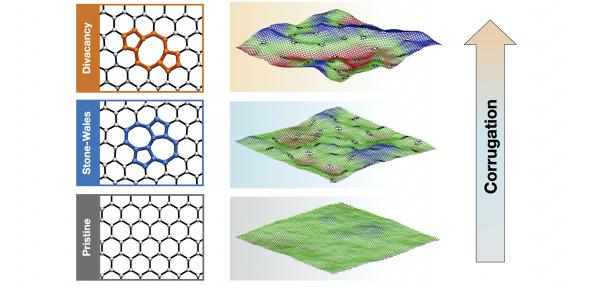
Defects and other perturbations govern the properties of crystalline materials. In particular, this applies to one-atom-thick two-dimensional graphene exhibiting a variety of remarkable properties strongly dependent on its atomic morphology and presence of defects. Advances in experimental techniques have made it increasingly possible to control the position, type, and distribution of defects in graphene offering the opportunity of atomically precise tailoring graphene’s structure and, thus, its properties. Despite the great potential of structurally modified graphene for several technological fields ranging from catalysis and hydrogen storage to lithium-ion batteries, the distinct coupling between defects and graphene’s intrinsic ripples and corrugation is still not well understood. Efficient nanoengineering, however, crucially requires knowledge of this relationship which would then be a powerful tool to further tailor graphene’s properties and thus accelerate the design and manufacture of graphene-based nanomaterials.
In collaboration with researchers from University College London, Imperial College London, and University of Naples Federico II we gain fundamental insight into the intrinsic relationship between graphene’s morphology and the nature and quantity of defects introduced by employing machine learning-based molecular dynamics simulations. Focusing on divacancies and Stone-Wales defects, we find that the magnitude of their structural impact varies significantly revealing, for the first time, the sensitivity of graphene’s corrugation with respect to the defect type. While both defect types enhance the corrugation of graphene (by up to 500% in case of the divacancies), the distinct mechanisms behind this morphological transformation are unique to the respective defect type and depends on their intrinsic geometry and their ability to interact with each other. As many of graphene’s properties, such as its reactivity or the diffusion of adsorbed molecules along the surface, strongly depend on its morphology, we are confident that our findings will be relevant for the investigation and design of many technologies.
